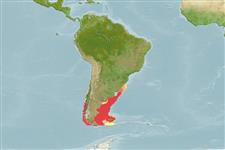Common names from other countries
Classification / Names / Names
Nomi Comuni | Sinonimi | Catalog of Fishes (gen., sp.) | ITIS | CoL | WoRMS
Environment: milieu / climate zone / depth range / distribution range
Ecologia
; distribuzione batimetrica 2 - 250 m (Ref. 87801). Temperate, preferred 12°C (Ref. 107945); 30°S - 55°S, 76°W - 50°W
Southeast Pacific and Southwest Atlantic: from Valparaiso to Magallanes, Rio Grande do Sul, Brazil then south to Falkland Islands.
Length at first maturity / Size / Peso / Age
Maturity: Lm ? range ? - ? cm Max length : 2.8 cm SHH maschio/sesso non determinato; (Ref. 81902)
Maximum length is based on data from Chile (Ref. 81902). Maximum depth from Ref. 111854. It is an infaunal species found on sandy, muddy, gravel and shell covered substrates at depths of 2 to 80 meters. Gonochoric species with free-living larvae (Ref. 87801). It is found in forests of Macrocystis pyrifera (Ref. 92889).
Life cycle and mating behavior
Maturità | Riproduzione | Deposizione | Uova | Fecundity | Larve
Members of the class Bivalvia are mostly gonochoric, some are protandric hermaphrodites. Life cycle: Embryos develop into free-swimming trocophore larvae, succeeded by the bivalve veliger, resembling a miniature clam.
SAUP Database. 2006. (Ref. 356)
IUCN Red List Status (Ref. 130435)
CITES status (Ref. 108899)
Not Evaluated
Not Evaluated
Human uses
Pesca: commerciale
FAO - pesca: landings | FishSource | Sea Around Us
Strumenti
Fonti Internet
Estimates based on models
Resilienza
Medio, tempo minimo di raddoppiamento della popolazione 1.4 - 4.4 anni (K=0.29).
